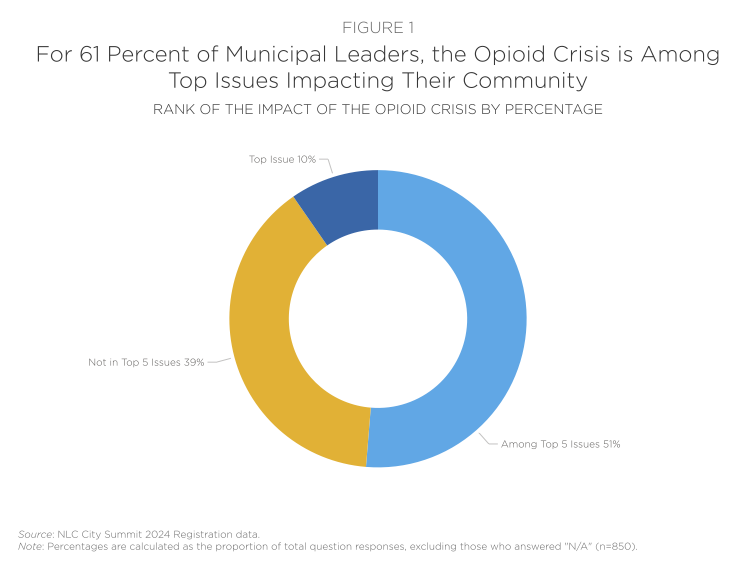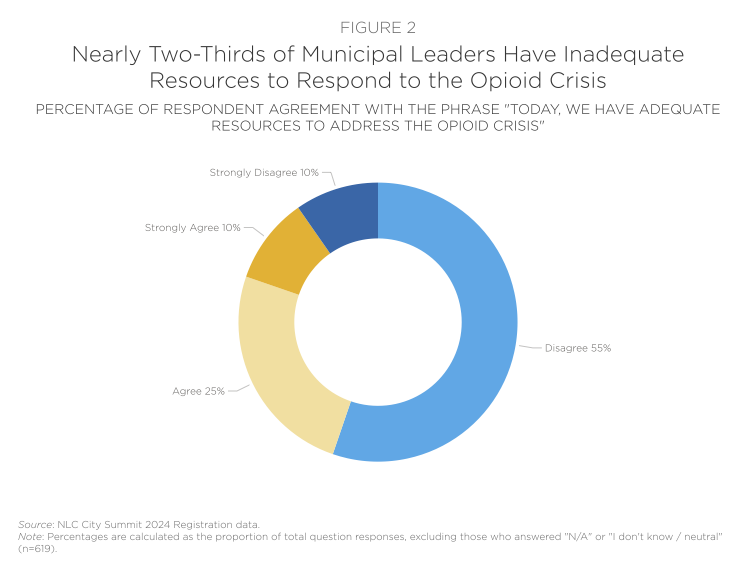Cities, towns and villages have long been on the frontlines of the nation’s opioid crisis. Over the last three decades, overdose deaths involving opioids increased dramatically. According to the CDC, nearly 727,000 people died from an opioid overdose between 1999 and 2022, and the number of opioid overdose deaths in 2022 was 10 times higher than in 1999. While recent national-level statistics indicate the impact of the opioid crisis may be subsiding, looking at the local experience is vital. National statistics do not always capture local perspectives and lived experiences. Many municipal leaders report ongoing challenges in tackling the opioid crisis in their communities.
Municipal Leaders Report Substantial Impact of Crisis
The need for attention to this issue is highlighted in a recent National League of Cities (NLC) survey of municipal leaders. Sixty-one percent of municipal leaders indicate the opioid crisis is one of the top issues — or the top issue — impacting their community.

Per NLC’s analysis, leaders of cities with more than 50,001 residents and municipal leaders in the Northeast are more likely to consider the opioid crisis a top issue for their community. Additionally, elected officials are more likely to rank the opioid crisis as a top issue, compared to other municipal staff roles.
Moreover, nearly two-thirds of municipal leaders have inadequate resources to respond to the opioid crisis.

For cities with more than 200,001 residents, resources may be stretched particularly thin: three-quarters of these responding city leaders report inadequate resources to respond to the opioid crisis (NLC analysis not shown here). About 78 percent of responding city leaders from states in the West indicate the same. CDC data confirms that several Western states in particular are struggling to address the opioid crisis: Alaska, Montana, Nevada and Utah demonstrate increases in predicted drug overdose deaths between August 2023 and August 2024, despite the national decrease of more than 21 percent in the same period.
The majority of municipal leaders responding to NLC’s survey indicate the opioid crisis remains a pressing issue for communities. As national-level statistics suggest the crisis may be improving, with opioid-related overdose deaths decreasing in recent years, it is important to understand both national and local substance use trends.
Reductions in Opioid Overdose Deaths Spark Hope
The opioid epidemic can be broken down in three waves.
- From 1999 to 2010, opioid prescriptions and overdose deaths involving prescription opioids increased steadily.
- From 2010 to 2013, there was a surge in the number of opioid overdose deaths involving heroin.
- From 2013 to present day, the crisis has been marked by a rapid, substantial increase in overdose deaths involving synthetic opioids such as fentanyl. In 2017, the opioid crisis was declared a national public health emergency.
However, the CDC reports that 2023 provisional data demonstrate a nearly 4 percent decrease in annual opioid-related overdose deaths from the previous year (from about 84,000 in 2022 to 81,000 in 2023). This marks the first annual decrease in overdose deaths related to opioid use since 2018.
More broadly, CDC data reveals predicted drug overdose deaths decreased 21.7 percent nationally from August 2023 to August 2024. Public health experts indicate this data demonstrates real progress in combatting the opioid crisis. NPR reports that health officials “believe catastrophic increases in drug deaths… have ended, at least for now. Many said a widespread, meaningful shift appears underway.”
The reduction in overdose deaths may indicate progress in combatting the crisis, but these statistics still leave tens of thousands of individuals dying from drug overdoses each year. Both fatal and nonfatal overdoses — and substance use in general — significantly impact communities and families across the nation, and local leaders are tasked with addressing health and safety for their residents. Despite reported advancements in addressing opioid and substance use crises on the national scale, municipal leaders report a long road to recovery.
Promoting Recovery at the Local Level
Local leaders communicate a critical need for resources to tackle the opioid and substance use crises at the local level. Many communities have made progress in addressing the substance use crisis and saving resident lives, but there is additional work to do toward opioid abatement and remediation.
The National Opioid Settlements directly allocated funds to thousands of state and local governments across the United States, enabling cities and counties to invest funds in evidence-based solutions to address their community’s needs. It is possible that reductions in drug overdose deaths are associated with the opioid settlement payouts as localities start funding strategies to support treatment and recovery. Many state and local governments report using settlement funds to purchase and distribute Naloxone and overdose reversal drugs, finance medication-assisted treatment (MAT), invest in prevention programs and support warm hand-off and recovery services. However, the opioid settlements will provide payouts to local governments over the course of many years to come. It is vital that local leaders continue to invest settlement dollars in meaningful public health initiatives for the sustained health and safety of residents.
The perspective of municipal leaders experiencing substance use crisis — reporting the ongoing, significant impact of the crisis today and the inadequacy of current resources — must serve as a grounding refrain for the nation’s opioid epidemic. While reductions in national drug overdose deaths suggest progress, state-by-state disparities and local perceptions continue to show substance use taking a toll on communities. NLC is committed to supporting communities and their leaders by providing evidence-based resources, action-oriented solutions and legal advocacy on behalf of local governments as they continue to lead the way in addressing our nation’s substance use crisis.











